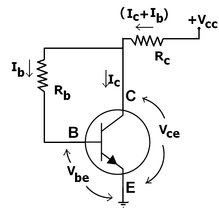Collector-to-base bias:

Figure: Collector-to-base bias
This configuration uses negative feedback to avoid thermal runaway and stabilize the operating point. In this category of biasing, the base resistor RB is associated to the collector in place of connecting it to the DC source Vcc. Thus any thermal runaway will induce a voltage drop across the RC resistor which will throttle the transistor's base current.
From voltage law of Kirchhoff, the voltage VRb across the base resistor Rb is

By the Ebers-Moll model, Ic = βIb, and thus:

From law of Ohm, the base current Ib = VRb/Rb, and thus

Therefore, the base current Ib is
Ib = Vcc - Vbe/ (Rb+ (β+1) RC)
If Vbe is held stable and temperature get increases, after that the collector current Ic increases. Though, a larger Ic causes the voltage drop across resistor Rc to increase that in turn decreases the voltage VRb across the base resistor Rb. A lower base-resistor voltage drop decreases the base current Ib that results in less collector current Ic. Since an increase in collector current with temperature is opposed, the operating point is reserved stable.